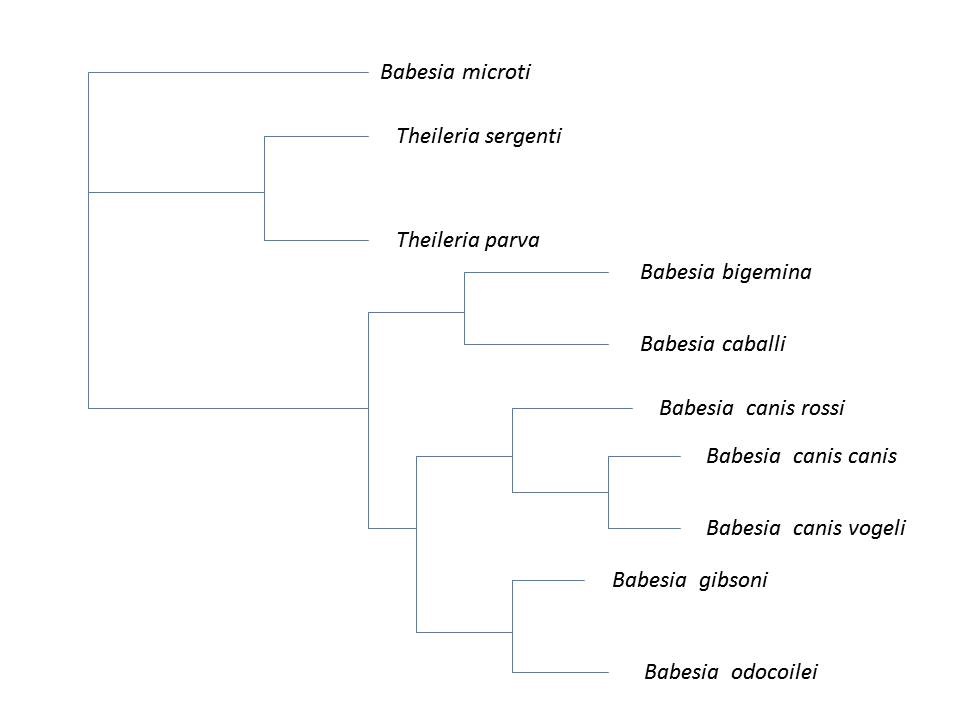Classification
Domain - Eukarya
Kingdom - Alveolata
Phylum - Apicomplexa
Class - Aconoidasida
Order - Piroplasmida
Family - Babesiidae
Genus - Babesia
Species - Babesia canis
Subspecies - vogeli, canis, and rossi
Domain Eukarya
"Eukarya" originates from two Greek root words meaning "true" and "nucleus." Babesia canis belongs to the Domain Eukarya because it has both a true nucleus and membrane-bound organelles.
Kingdom Alveolata
Organisms in the Kingdom Alveolata have the unique charactersitic of cortical alveoli. B. canis is categorized as an alveolate because of the flattened vesicles (cortical alveoli) under its outer membrane.
Phylum Apicomplexa
The Phylum Apicomplexa is composed of parasitic protozoans, most of which feed off of an animal's blood through a blood-sucking arthropod. This vector-to-host process is used by the parasite B. canis, qualifying it as an apicomplexan.
Class Aconoidasida
B. canis is classified in the Class Aconoidasida because, as the Greek prefix indicates, it is lacking a particular feeding structure called a "conoid" (a-conoid) in its full life-cycle.
Order Piroplasmida
Piroplasmids are parasites that are host and vector specific. A
synapomorphy of the piroplasmids is the trophozoite stage of the
life cycle, which can be separated from an erythrocyte by a single
membrane, unlike the usual two membranes. Piroplasmids are unique in
to dogs, though in some cases it has been found in other mammals
(Lack et al. 2012). Nutrition is obtained by
feeding on the blood the vector eats as well as the canine host’s blood. Two
families are derived from this order, Babesiidae and Theileriidae
(Criado-Fornelio et al. 2003).
Family Babesiidae
Babesiidae is a parasite that reproduces via binary fission or
schizogony. Depending on the part of the lifecycle it is in, it can
be round, piriform, or oval. Babesiidae feeds upon the erythrocytes
of its mammalian host, or off of its tick vector. If Babesiidae
infects its host, the host may develop a disease (Canning and Winger,
1987).
Genus Babesia
The genus Babesia can be classified as a tick transmitted
hemoprotozooan. Babesia tends to be transmitted into a mammalian or
bird host via a tick vector. Thus it is a huge concern to those in
the agriculture field, or anyone with pets. The lifecycle of Babesia
is thought to be derived via tick vector, and thus has evolved to
using ticks for transmission exclusively (Schnittger et al.
2012).
Species Babesia canis
Babesia canis is a parasite of the genus babesia that primarily
affects dogs. These parasites feast upon blood meals while within
both the tick vector and mammalian host. B. canis is very specific
to the tick vector and tends to be different depending on the
geography in which it resides. Different dog hosts have developed
various level of immunities to B. canis, though none are completely
immune (Chauvin et al. 2009).
Figure 1. Phylogenetic tree of the relation between several
Babesia species. Adapted by T. Kusiak from the diagram of Caccio et al. 2002.

The three subspecies of B. canis are related in a particular way. B. canis canis, and B. canis vogeli form a sister taxa, while B. canis rossi speciated before them from the most recent common ancestor of the three (Figure 1.). Effectively, rossi has the most distinct form and deadliest effect on its host, while canis and vogeli are both more similar to each other than to rossi, in both form and function.
Babesia gibsoni is one of the most closely related parasites to the species Babesia canis. Both may infect dogs and cause hemolytic anemia and are transferred by a similar (if not the same) tick vector. However, they differ in form and size. Babesia canis is larger and recognized as “pear-shaped” whereas B. gibsoni is much smaller and harder to detect (French et al.) (Figure 2). Babesia odocoilei is comparable to B. canis in much the same way.
Figure 2. An example of Babesia canis (top panel) and Babesia gibsoni (lower panel). Used with permission from Cornell University; original image located on "eClinPath" website at Cornell University. Located here after June 2014.
Figure 3. Babesia canis with relation to other Apicomplexans. Modified from Hikosaka, K et al. 2012.
This phylogenetic tree shows the relationship between the
Archaeoplasmids, Theilerids, and Bebesids. Archaeoplasmids are
unique because they undergo binary fission (asexual) and sexual life
cycles. Theilerids are parasitic protozoan's that belong to the
phlum Apicomplexa. Bebesids are a unique group of parasites that are
highly specific to the species of vector, as well as host, that they
parasitize (Hikosaka,
et al.
2012).
Keep learning and go to the habitat page! Home




